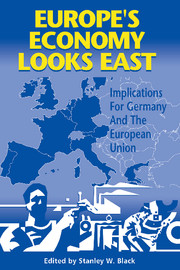Book contents
- Frontmatter
- Contents
- List of figures and tables
- Preface
- List of conference participants
- List of acronyms
- 1 Introduction
- I Trade relations
- 2 An economic assessment of the integration of Czechoslovakia, Hungary, and Poland into the European Union
- Comments
- 3 Potential trade with core and periphery: industry differences in trade patterns
- Comments
- 4 Impact on German trade of increased division of labor with Eastern Europe
- Comments
- II Investment patterns
- III Labor market issues
- IV The process of integration
- Index
Comments
Published online by Cambridge University Press: 03 February 2010
- Frontmatter
- Contents
- List of figures and tables
- Preface
- List of conference participants
- List of acronyms
- 1 Introduction
- I Trade relations
- 2 An economic assessment of the integration of Czechoslovakia, Hungary, and Poland into the European Union
- Comments
- 3 Potential trade with core and periphery: industry differences in trade patterns
- Comments
- 4 Impact on German trade of increased division of labor with Eastern Europe
- Comments
- II Investment patterns
- III Labor market issues
- IV The process of integration
- Index
Summary
Discussing this paper is a pleasure, something like watching a movie. I'm spared the tedious screenwriting, casting, shooting, reshooting, and editing. I have only to focus on the finished product. Is it compelling? Is it enriching? How does it come out at the end?
Computable general equilibrium approaches are, indeed, more than a little like a movie. They simulate life. And this one does so in a compelling, enriching way.
Here's how it comes out at the end. Rationalization rules victorious. Factor adjustment burdens are overwhelmed. Almost everyone lives happily ever after. That is to say, the authors portray integration of Czechoslovakia, Hungary, and Poland into the European Union as leading to three important consequences. There are significant predicted gains in economic efficiency, some of the conventional kind and some because surviving firms in these countries economize on fixed costs more effectively in the face of larger markets. There are only mild predicted displacements of workers from sectors that shrink, and also only mild adjustments in wages and capital returns (though displacements, i.e., deaths, of “firms” are not so mild). And the predicted gains in the typical citizen's standard of living are so large (between 3 and 7 percent) that most workers, even when displaced, gain back enough to offset any mild temporary displacement losses (rarely double-digit).
- Type
- Chapter
- Information
- Europe's Economy Looks EastImplications for Germany and the European Union, pp. 61 - 66Publisher: Cambridge University PressPrint publication year: 1997



